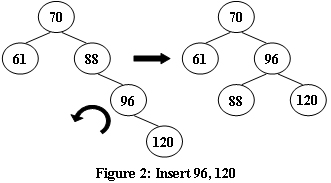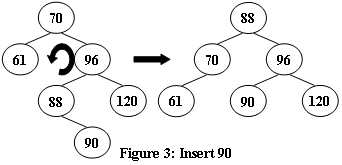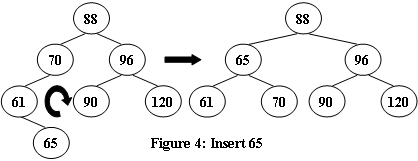概念
AVL(Adelson-Velskii and Landis)树得名于它的发明者 G.M. Adelson-Velsky 和 E.M. Landis,他们在 1962 年的论文《An algorithm for the organization of information》中发表了它。
AVL树是一种自平衡二叉搜索树。
特征

- 满足二叉搜索树的特征,即任何一个节点的值比左孩子的值大,比右孩子的值小
- 在二叉搜索树的基础上,任何一个节点的左右子树高度差不超过1
构建AVL树
参考博客:https://www.cnblogs.com/skywang12345/p/3576969.html
出现不平衡的4种情况


- LL: LeftLeft,也称为"左左"。插入或删除一个节点后,根节点的左子树的左子树还有非空子节点,导致"根的左子树的高度"比"根的右子树的高度"大2,导致AVL树失去了平衡。
- RR:RightRight,称为"右右"。插入或删除一个节点后,根节点的右子树的右子树还有非空子节点,导致"根的右子树的高度"比"根的左子树的高度"大2,导致AVL树失去了平衡。
- LR:LeftRight,也称为"左右"。插入或删除一个节点后,根节点的左子树的右子树还有非空子节点,导致"根的左子树的高度"比"根的右子树的高度"大2,导致AVL树失去了平衡。
- RL:RightLeft,称为"右左"。插入或删除一个节点后,根节点的右子树的左子树还有非空子节点,导致"根的右子树的高度"比"根的左子树的高度"大2,导致AVL树失去了平衡。
旋转
1. LL的旋转

2. RR的旋转

3. LR的旋转

4. RL的旋转

练习题
PAT 1066 Root of AVL Tree
Description
An AVL tree is a self-balancing binary search tree. In an AVL tree, the heights of the two child subtrees of any node differ by at most one; if at any time they differ by more than one, rebalancing is done to restore this property. Figures 1-4 illustrate the rotation rules.
Input Specification
Each input file contains one test case. For each case, the first line contains a positive integer N (≤20) which is the total number of keys to be inserted. Then N distinct integer keys are given in the next line. All the numbers in a line are separated by a space.
Output Specification
For each test case, print the root of the resulting AVL tree in one line.
Sample Input 1:
5
88 70 61 96 120
Sample Output 1:
70
Sample Input 2:
7
88 70 61 96 120 90 65
Sample Output 2:
88
AC code
代码参考:https://www.liuchuo.net/archives/2178
#include <stdio.h>
#include <iostream>
using namespace std;
struct node{
int val;
struct node *left, *right;
};
int getHeight(node *root){
if(root == NULL) return 0;
return max(getHeight(root->left), getHeight(root->right)) + 1;
}
node *rotateLeft(node *root){
node *t = root->right;
root->right = t->left;
t->left = root;
return t;
}
node *rotateRight(node *root){
node *t = root->left;
root->left = t->right;
t->right = root;
return t;
}
node *rotateLeftRight(node *root){
root->left = rotateLeft(root->left);
return rotateRight(root);
}
node *rotateRightLeft(node *root){
root->right = rotateRight(root->right);
return rotateLeft(root);
}
node *insert(node *root, int val){
if(root == NULL){
root = new node();
root->val = val;
root->left = NULL; root->right = NULL;
}else if(val < root->val){
root->left = insert(root->left, val);
if(getHeight(root->left) - getHeight(root->right) == 2)
root = val < root->left->val? rotateRight(root): rotateLeftRight(root);
}else{
root->right = insert(root->right, val);
if(getHeight(root->left) - getHeight(root->right) == -2)
root = val > root->right->val? rotateLeft(root): rotateRightLeft(root);
}
return root;
}
int main(){
int n, val;
scanf("%d", &n);
node *root = NULL;
for(int i = 0; i < n; i++){
scanf("%d", &val);
root = insert(root, val);
}
printf("%d", root->val);
return 0;
}


